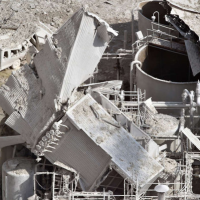ExxonMobil Fined for Blast at Torrance Refinery; Ready to Fire It Back Up
 Exxon/Mobil refinery blast in Torrance (photo: Brad Graverson, Torrance Daily Breeze)
Exxon/Mobil refinery blast in Torrance (photo: Brad Graverson, Torrance Daily Breeze)
The ExxonMobil refinery explosion in Torrance last February that costs Californians an estimated 6 to 10 cents a gallon of gas was caused by the failure of the critical fluid catalytic cracker unit, which hadn’t worked properly for nine years.
The California Division of Occupational Safety and Health (Cal/OSHA) cited that lapse (pdf) in assessing the company a $566,600 fine last week for 19 violations of workplace and health regulations. All but one of the violations were classified as serious because they could have led to workers deaths. No one died in the blast, which shook the city, spewed debris and chemicals into the air, and covered large portions of Torrance with a suspicious ash.
A safety review in 2007 found that ExxonMobil could not monitor the pressure in the unit’s electrostatic precipitator, which could explode during a flammable vapor leakage. The company didn’t fix it, and that’s what happened in February.
Clyde Trombettas, with the state Department of Industrial Relations (DIR), told the Torrance Daily Breeze, “It’s pretty rare for a compliance officer to issue one willful citation, let alone six willful citations. An employer has to be pretty egregious for us to do something like that. It’s trying to send a message that we need to take these things seriously.”
Mission accomplished. ExxonMobil spokesman told the Los Angeles Times, “We are reviewing the citations to determine the appropriate administrative and legal next steps. “We have, and will continue to work cooperatively with Cal/OSHA.”
The unit was shut down and the sprawling refinery has worked at greatly diminished capacity since the explosion, but ExxonMobil wants to begin large-scale gasoline production next month. The company submitted paperwork to the South Coast Air Quality Management District (AQMD) last week but questions remain about how well ExxonMobil’s older equipment can control emissions and remain safe.
The Daily Breeze reported that the company wants to use an older electrostatic precipitator that was replaced in 2009 by one that was destroyed in the exposition. AQMD spokesman Sam Atwood said that’s problematic. “The issue is that it’s going to be anywhere from two to six times the emissions of the newer unit that was destroyed in the explosion.”
AQMD wants ExxonMobil to limit production to 65,000 barrels a day to reduce emissions, at least until a new electrostatic precipitator can be put in place. The oil company wants more production. The plant used to produce 155,000 barrels before ExxonMobil blew it up.
–Ken Broder
To Learn More:
Torrance Leaders Question ExxonMobil’s Credibility on Safety in Wake of State Accusations (by Nick Green, Torrance Daily Breeze)
Exxon Mobil Fined $566,600 for Torrance Refinery Explosion (by Veronica Rocha, Los Angeles Times)
The ExxonMobil Explosion That Nobody Is Talking About (by Sacha Feinman, ThinkProgress)
Citation and Notification of Penalty (California Department of Industrial Relations Division of Occupational Safety and Health) (pdf)
- Top Stories
- Controversies
- Where is the Money Going?
- California and the Nation
- Appointments and Resignations
- Unusual News
- Latest News
- California Forbids U.S. Immigration Agents from Pretending to be Police
- California Lawmakers Urged to Strip “Self-Dealing” Tax Board of Its Duties
- Big Oil’s Grip on California
- Santa Cruz Police See Homeland Security Betrayal in Use of Gang Roundup as Cover for Immigration Raid
- Oil Companies Face Deadline to Stop Polluting California Groundwater





